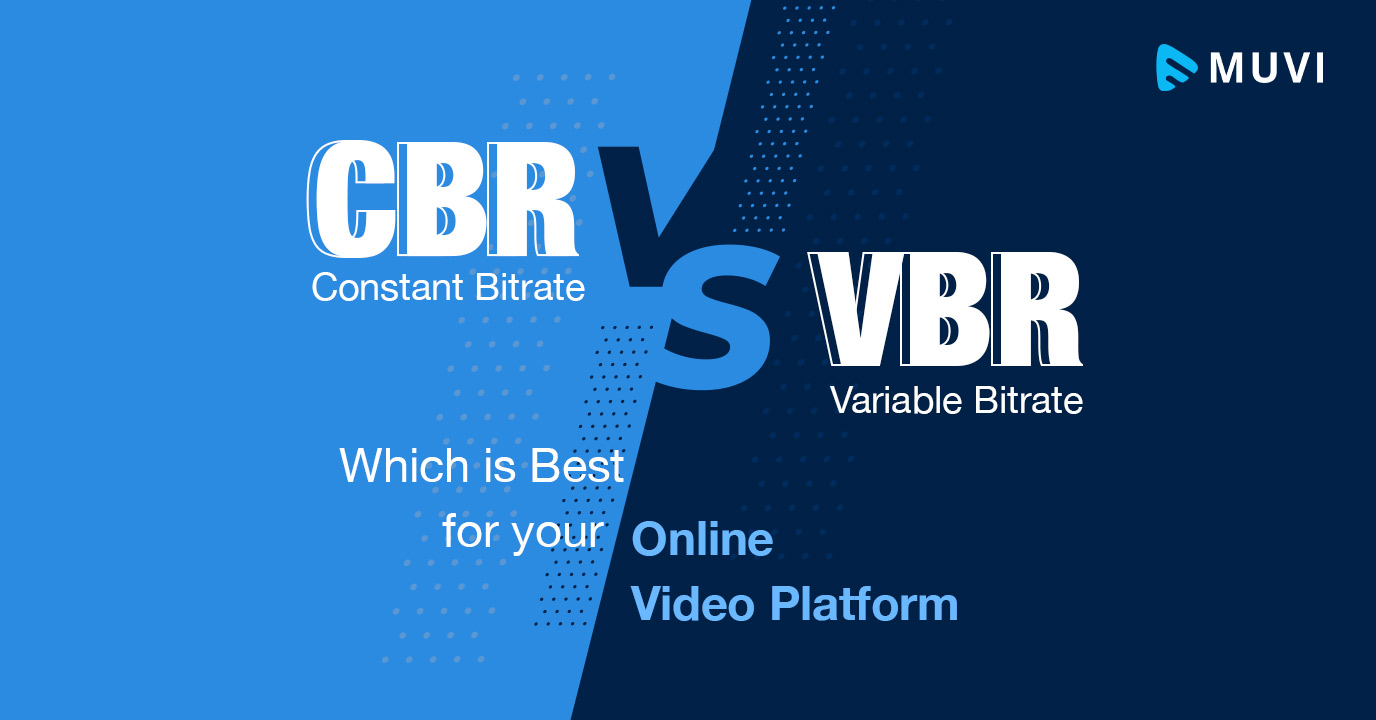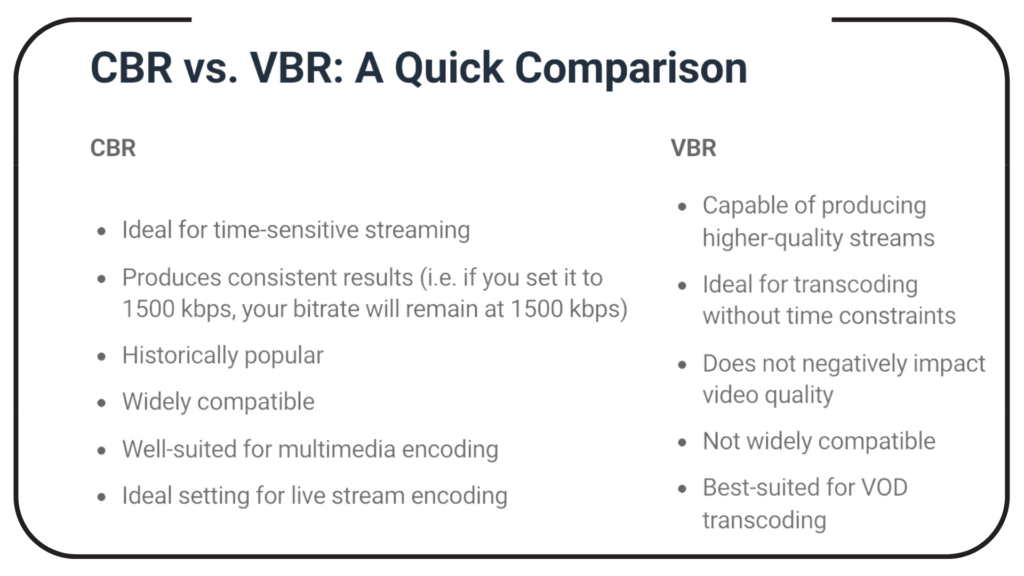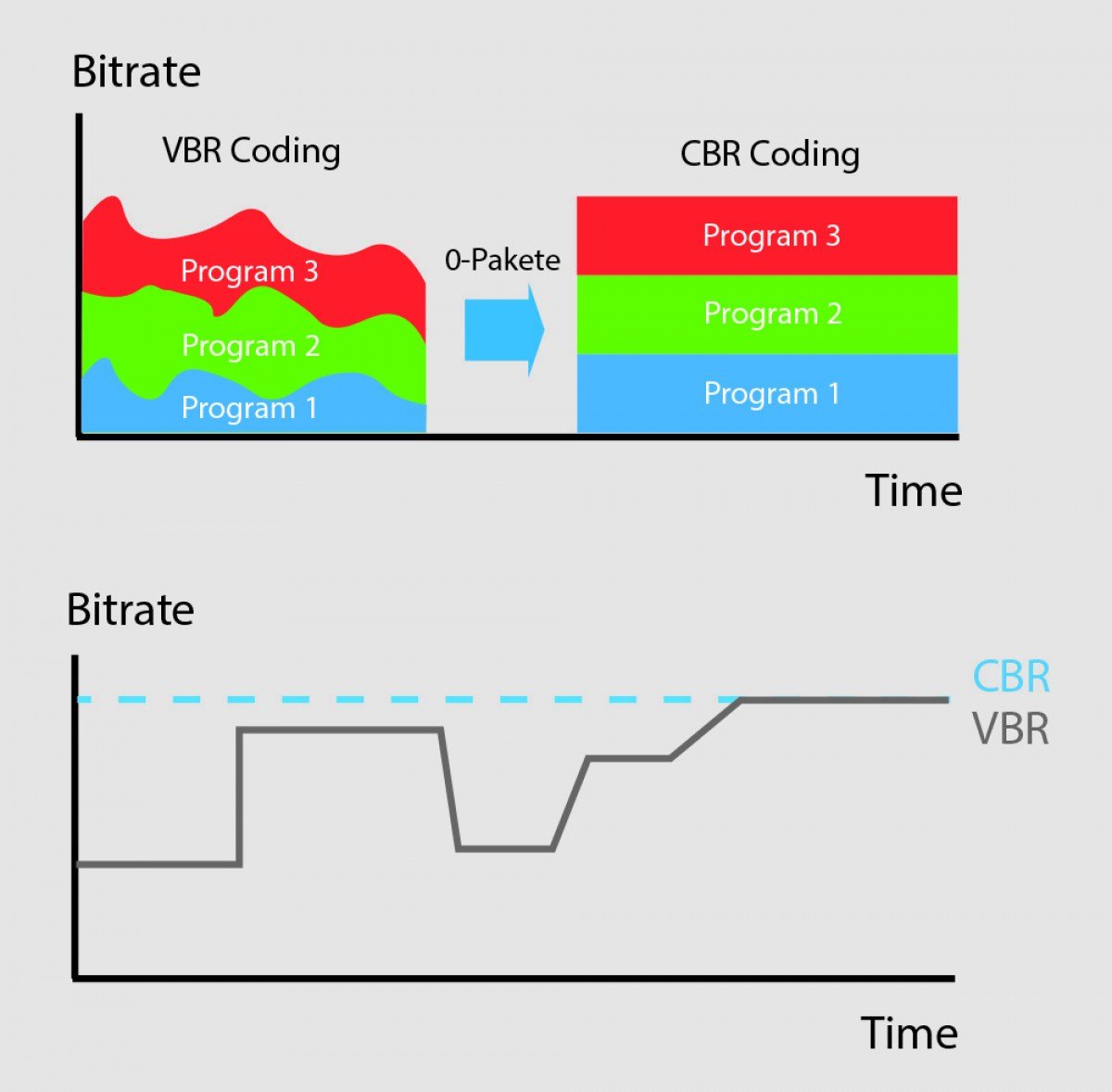Constant Bit Rate (CBR) delivers a fixed data rate throughout the media, ensuring consistent playback. Variable Bit Rate (VBR) adjusts the data rate based on the complexity of the audio or video, optimizing quality and file size.
Understanding the difference between Constant Bit Rate (CBR) and Variable Bit Rate (VBR) is essential for audio and video encoding. CBR maintains a steady bit rate, which simplifies streaming and ensures smooth playback. This can be beneficial for live broadcasts where consistency is crucial.
On the other hand, VBR offers flexibility by allocating more bits to complex segments and fewer bits to simpler parts. This results in better overall quality and smaller file sizes, making it a popular choice for music and films. Choosing the right bit rate method can significantly affect your media’s performance and quality.
Introduction To Bit Rate In Streaming
Bit rate plays a key role in streaming media. It affects quality and performance. Two common types are Constant Bit Rate (CBR) and Variable Bit Rate (VBR). Understanding these can improve your streaming experience.
Importance Of Bit Rate
Bit rate defines the amount of data transmitted over time. It influences video and audio quality. Higher bit rates offer better quality but require more bandwidth.
- CBR: Maintains a steady bit rate.
- VBR: Adjusts the bit rate based on content.
Choosing the right bit rate is crucial for:
- Streaming quality
- Buffering times
- Data usage
Basic Concepts
Understanding basic terms helps in making informed choices.
| Term | Definition |
|---|---|
| Bit Rate | Data transmitted per second in a stream. |
| CBR | Fixed bit rate throughout the stream. |
| VBR | Variable bit rate based on complexity. |
Understanding these concepts enhances your streaming quality. Users can select the best option for their needs.

Diving Into Constant Bit Rate (cbr)
Constant Bit Rate (CBR) is a method used for encoding audio and video files. It maintains a fixed data rate throughout the entire file. This approach has its unique advantages and disadvantages. Understanding CBR helps in making better choices for streaming and file storage.
How Cbr Works
CBR works by keeping the same amount of data processed each second. This means the file size is predictable and consistent. Here’s how it functions:
- Data is sent at a constant rate.
- File size can be easily calculated.
- Playback remains smooth with minimal buffering.
CBR is often used in live broadcasts and streaming services. It ensures that the data flow is steady. This consistency helps avoid interruptions during playback.
Pros And Cons
| Pros | Cons |
|---|---|
| Predictable file size | Less efficient in terms of quality |
| Smooth playback | Wasted space in silent sections |
| Easy to stream | Not suitable for all types of content |
CBR is excellent for specific uses. It guarantees a steady stream, but it may not always offer the best quality. Consider the content type before choosing CBR.
Exploring Variable Bit Rate (vbr)
Variable Bit Rate (VBR) is a method used in audio and video encoding. It adjusts the data rate based on the complexity of the content. This allows for better quality in certain scenes while saving space in others.
Functionality Of Vbr
VBR works by analyzing the media being encoded. It changes the bit rate dynamically during playback. The main features include:
- Dynamic Adjustment: The bit rate varies based on content needs.
- Quality Preservation: Higher bit rates for complex scenes.
- Space Efficiency: Lower bit rates for simpler scenes.
This results in a more efficient use of storage without sacrificing quality.
Advantages And Disadvantages
Understanding the pros and cons of VBR is essential. Here’s a quick overview:
| Advantages | Disadvantages |
|---|---|
|
|
VBR can enhance user experience but comes with some trade-offs. Knowing these can help in making informed choices.

Comparative Analysis Of Cbr And Vbr
Understanding the differences between Constant Bit Rate (CBR) and Variable Bit Rate (VBR) is essential for optimizing media streaming. Each method has unique advantages and limitations. This section explores key aspects: quality, consistency, and bandwidth utilization.
Quality And Consistency
Quality is crucial for audio and video files. CBR maintains a steady bitrate. This leads to consistent playback quality. However, CBR may sacrifice quality during complex scenes.
VBR adjusts bitrate based on content complexity. It provides higher quality during challenging segments. Users experience varying quality, which can be both an advantage and a drawback.
| Feature | CBR | VBR |
|---|---|---|
| Bitrate | Constant | Variable |
| Quality | Consistent | Dynamic |
| Use Case | Streaming | High-quality audio/video |
Bandwidth Utilization
Bandwidth utilization plays a significant role in streaming. CBR uses a fixed amount of data. It can waste bandwidth during simple scenes.
- Pros of CBR:
- Predictable data usage
- Simple encoding
- Cons of CBR:
- Less efficient during low-complexity scenes
- Potential quality loss
VBR adjusts data use based on content. This leads to better bandwidth efficiency. It conserves data during simple scenes.
- Pros of VBR:
- Better quality during complex scenes
- More efficient bandwidth use
- Cons of VBR:
- Unpredictable data usage
- Complex encoding process
Choosing between CBR and VBR depends on specific needs. Consider your priorities for quality and bandwidth.
Optimal Settings For Streaming
Choosing the right settings for streaming is crucial. It affects both video quality and performance. Two popular options are Constant Bit Rate (CBR) and Variable Bit Rate (VBR). Understanding their differences helps you make informed choices.
Choosing Between Cbr And Vbr
Both CBR and VBR have unique advantages:
- Constant Bit Rate (CBR): Maintains the same bit rate throughout the stream. This consistency ensures smooth playback, especially on limited bandwidth connections.
- Variable Bit Rate (VBR): Adjusts the bit rate based on the complexity of the video. This flexibility often results in better quality for varying scenes.
Consider your streaming needs:
- Use CBR for live broadcasts or gaming streams.
- Opt for VBR when uploading pre-recorded videos.
Recommended Settings
Here are recommended settings for both CBR and VBR:
| Bit Rate Type | Recommended Bit Rate | Ideal Use Case |
|---|---|---|
| CBR | 2500 – 6000 kbps | Live Streaming |
| VBR | 1500 – 3000 kbps (average) | Pre-recorded Videos |
Test your settings. Adjust based on your audience’s internet speed. Always prioritize video quality for the best viewer experience.
Real-world Applications
Understanding Constant Bit Rate (CBR) and Variable Bit Rate (VBR) helps in various fields. Different uses demand different approaches. Let’s explore their applications in streaming, gaming, and live broadcasting.
Streaming Platforms
Streaming platforms rely on fast delivery of audio and video. CBR ensures a steady flow. VBR allows for better quality at varying bandwidths.
- CBR Advantages:
- Consistent quality across all devices.
- Predictable bandwidth usage.
- VBR Advantages:
- Higher quality in complex scenes.
- Efficient use of bandwidth.
| Platform | Preferred Bit Rate | Reason |
|---|---|---|
| Netflix | VBR | Maximizes video quality. |
| YouTube | CBR | Ensures smooth playback. |
Gaming And Live Broadcasting
In gaming, low latency is crucial. Players need smooth graphics and fast response times. CBR keeps the stream stable, while VBR enhances details.
- CBR in Gaming:
- Consistent frame rates.
- Less buffering during gameplay.
- VBR in Broadcasting:
- Improved visual quality in action scenes.
- Adaptive to network changes.
Choosing between CBR and VBR depends on the specific needs. Each method serves different purposes effectively.
Technical Challenges And Solutions
Understanding the technical challenges of Constant Bit Rate (CBR) and Variable Bit Rate (VBR) is crucial. Both methods face unique obstacles. Solutions exist to overcome these issues and improve performance.
Adaptive Streaming
Adaptive streaming adjusts the video quality based on network conditions. This method helps deliver smooth playback. Here are some key points:
- Quality Adjustment: Automatically changes video quality.
- Buffering Reduction: Reduces chances of buffering.
- Bandwidth Efficiency: Uses available bandwidth wisely.
Adaptive streaming works well with VBR. It allows better quality in good conditions. In poor conditions, it lowers the quality to maintain playback.
Network Limitations
Network limitations affect both CBR and VBR streaming. Bandwidth and latency can hinder performance. Here’s a breakdown:
| Challenge | Impact on Streaming | Potential Solution |
|---|---|---|
| Low Bandwidth | Causes buffering and interruptions | Use lower resolution or adaptive streaming |
| High Latency | Delays video start and playback | Optimize server response times |
| Network Congestion | Degrades video quality | Implement adaptive bitrate streaming |
Understanding these limitations helps in creating better streaming experiences. Solutions such as adaptive streaming can mitigate issues. It is essential to optimize network use for smooth playback.
Future Of Streaming Bit Rates
The future of streaming bit rates is bright and evolving. Streaming technology keeps changing. Constant Bit Rate (CBR) and Variable Bit Rate (VBR) play a key role. Users demand high-quality content with minimal buffering. Understanding these bit rates helps us grasp future trends.
Technological Advancements
Technology is advancing rapidly. Here are some key advancements influencing streaming bit rates:
- 5G Networks: Faster internet speeds allow for higher quality streams.
- AI Algorithms: These can optimize streaming quality dynamically.
- Adaptive Streaming: This technology adjusts quality based on the user’s bandwidth.
- Cloud Computing: It enhances storage and processing capabilities.
These advancements lead to a better user experience. They enable seamless streaming with minimal interruptions.
Predictions And Trends
The industry is seeing interesting trends:
- Increased Use of VBR: More platforms will adopt VBR for better efficiency.
- Focus on User Experience: Quality will become more important than ever.
- Global Connectivity: More users will demand high-quality streams worldwide.
- Emerging Technologies: Innovations like VR and AR will require higher bit rates.
Experts predict these trends will shape the future of streaming.
Understanding these changes helps consumers choose the best streaming options.

Frequently Asked Questions
What Is Constant Bit Rate (cbr)?
Constant Bit Rate (CBR) is a method of encoding audio or video data. It maintains a consistent data rate throughout the entire file. This ensures predictable file sizes and bandwidth usage, making it ideal for streaming applications. CBR is commonly used in scenarios where timing is crucial, such as live broadcasts.
What Is Variable Bit Rate (vbr)?
Variable Bit Rate (VBR) adjusts the data rate according to the complexity of the audio or video content. This means that more complex sections use higher bit rates, while simpler sections use lower rates. VBR can provide better quality at smaller file sizes, making it popular for music and video streaming.
When Should I Use Cbr?
Use CBR when you need consistent data delivery and predictable file sizes. It’s especially beneficial for live streaming and broadcasting. CBR ensures that the stream remains stable, which is crucial for real-time applications. However, it may not provide the best quality for complex scenes compared to VBR.
When Is Vbr Preferred Over Cbr?
VBR is preferred when quality is a priority and file size can vary. It adapts to the content, offering better audio and video fidelity. This makes it ideal for music files and video-on-demand services. However, it may lead to unpredictable file sizes, which can be a drawback.
Conclusion
Choosing between Constant Bit Rate (CBR) and Variable Bit Rate (VBR) depends on your needs. CBR offers consistency, making it ideal for streaming. VBR provides better quality and efficiency, perfect for storage. Understanding these differences helps you make informed decisions for your audio and video projects.
Optimize your content for the best results.



